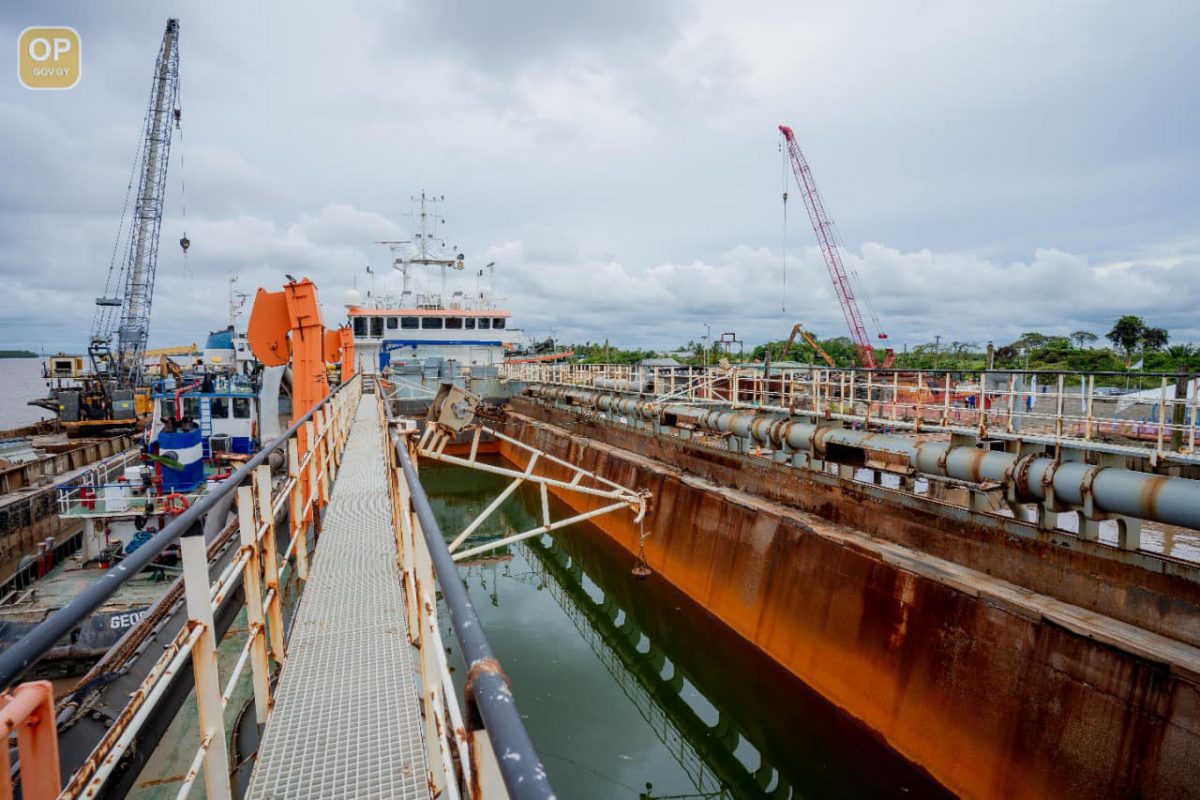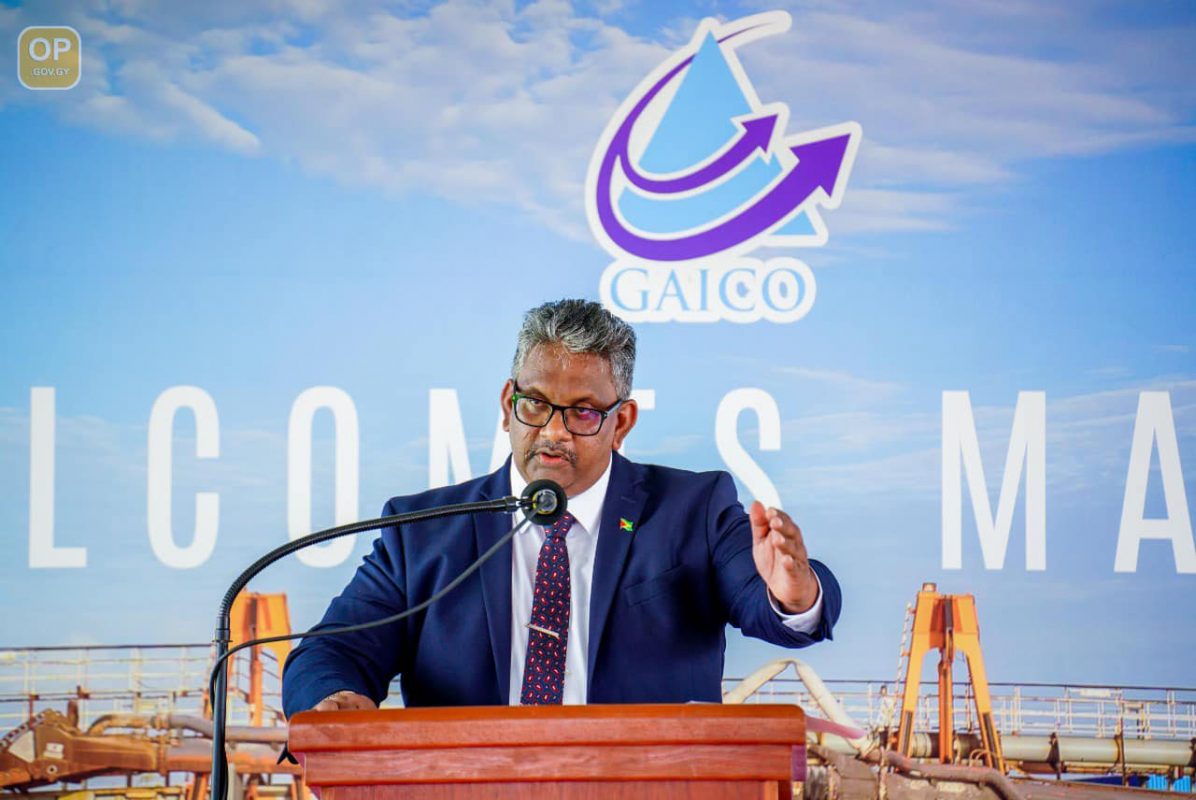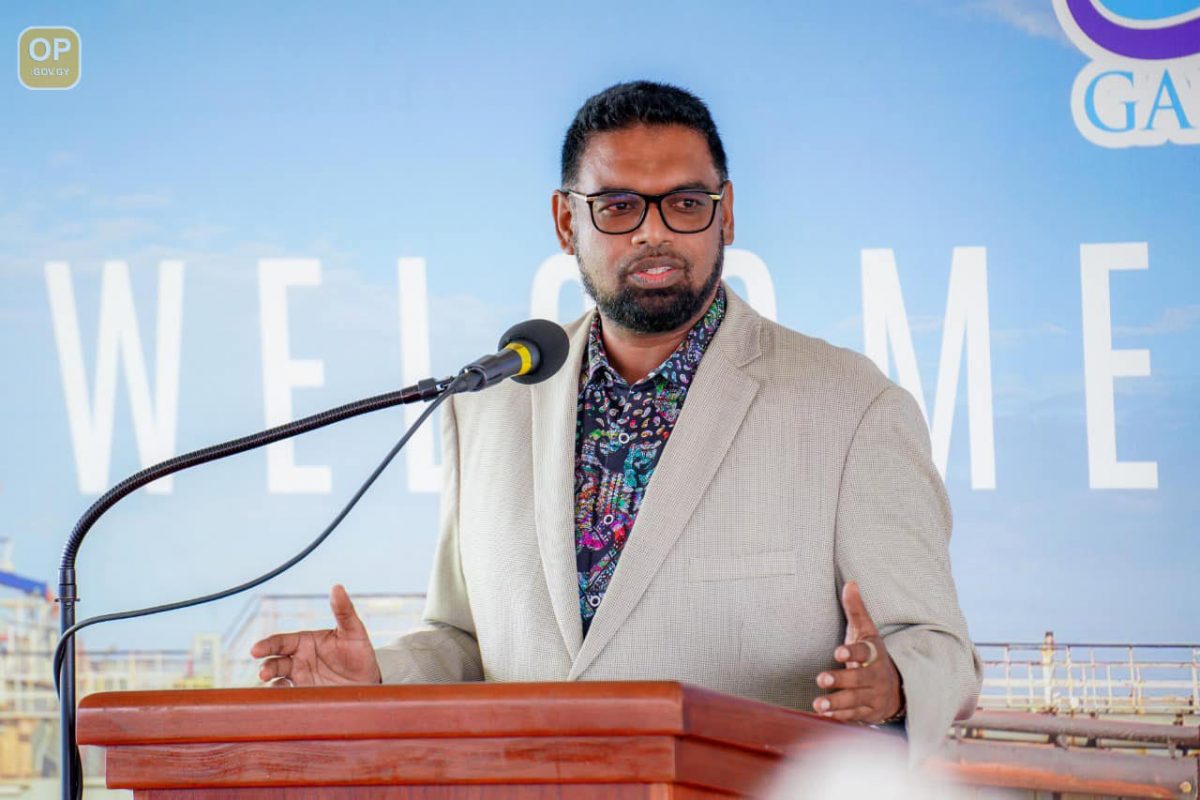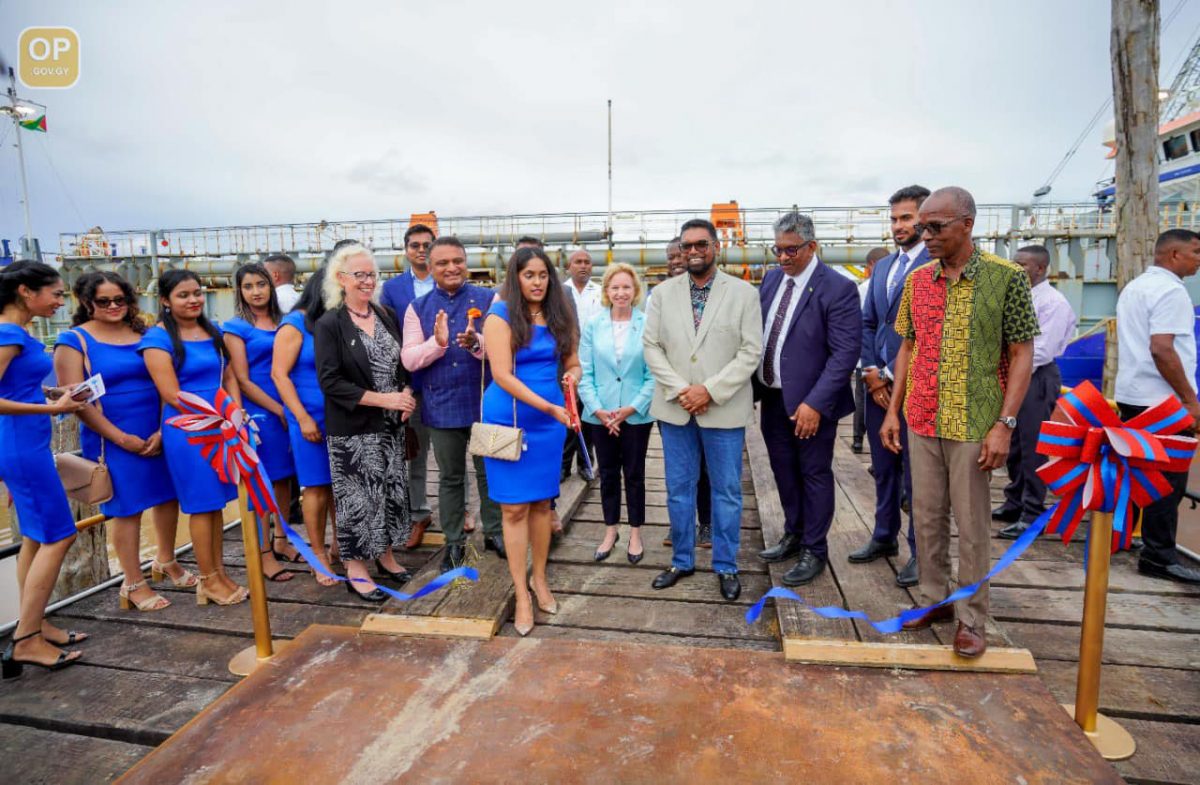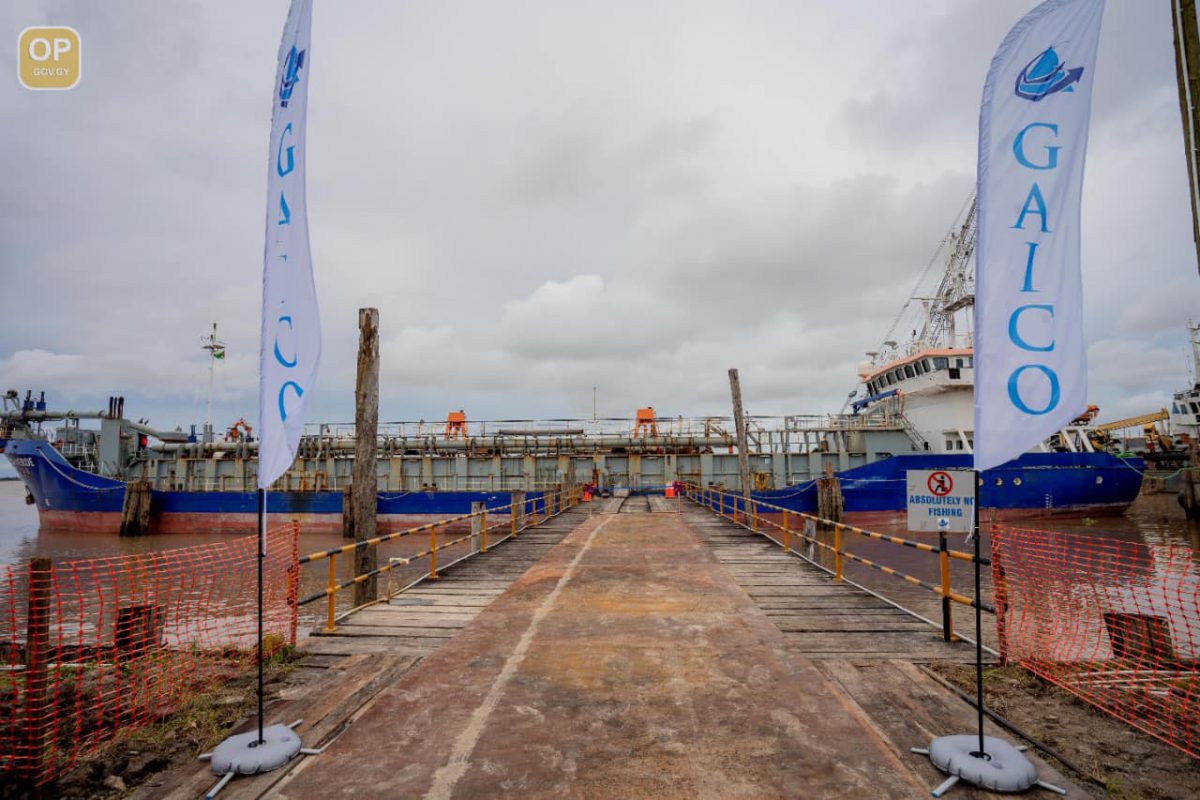GAICO Construction and General Services Inc on Saturday increased its dredging capabilities with the addition of a new US$7.5 million dredge that was commissioned by President Irfaan Ali at the company’s Nismes, West Bank Demerara wharf.
Malavi, a trailing suction hopper dredge, was added to GAICO’s existing fleet of hooper, cutter head and hydraulic cutter head dredges.
The company is also slated to add a new 18-inch cutter head dredge to its fleet, shortly, and according to Chief Executive Officer Komal Singh, that will cost about US$2.5 million.
Malavi recently arrived in Guyana and according to the company, it will significantly boost dredging capabilities within the country and ultimately provide opportunities for more employment.
GAICO’s CEO Singh said that the new additions would enable the company to increase its capacity and provide another opportunity to build local capacity within its team to align itself to take advantage of the emerging opportunities.
“Now that we see all the new development that the government is pushing for Guyana and for every single region without exception, we have decided to invest on a larger dredge. You see we have the dredge out here Malavi but we have invested on this dredge and another brand new cutter head 18-inch dredge to the tune of US$10 million,” Singh told the commissioning ceremony.
He said that US$10 million is a massive increase in the investment portfolio of the company since investment capital has been pegged at just around US$1 million over a three to four year period. However, he justified the massive jump by saying “we have a government today that supports the private sector in a very, very big way.”
“[We have] a government today that sees the need and the need of our economy and the need of getting the private sector up to speed so that they can be that true engine of growth to develop our country and for that GAICO will continue to make bold investments in this country,” Singh said.
He added that GAICO would continue to create strategic partnerships around the world in order to bring the expertise and the skills needed to elevate local content and to be able to function effectively in areas of opportunity where it does not have the requisite skill set. Singh told the gathering that the company started its dredging operation in 2010 with a simple tug and barge with a super long reach excavator. He related that it was not until 2014 that GAICO started to invest in bigger machinery to increase capacity with the acquisition of a cutter head dredge and then a trailing suction hopper dredge in 2015.
“There was always this conversation in Guyana, and many of you in the shipping industry would notice, for us to have a 24/7 deepwater port and that need now is becoming more and more critical with Guyana becoming an oil-producing nation. It is imperative for us to have some of these rivers dredged and so a lot of deeper draft, so vessels can get in and out of our channel. So we can all enjoy better economies of scale for importation,” Singh said.
“Over the last five or six years our investment in the dredging industry has been under tremendous pressure and I say so, simply because somewhere along the line, leaders have not recognized the importance of dredging our river mouth not just for bigger vessels to get into our waterway but to help farmers in the outlying areas of Georgetown, in Pomeroon, in Mahaica, Mahaicony to clear those outfall to mitigate flooding. So we had these two pieces of equipment sitting here with almost 40% utilization,” he added.
Singh said that GAICO is also building a wharf and dry dock facility at Nismes, West Bank Demerara. The completion of the first phase will see a laydown yard, a one-finger-pier and the wharf front at the Nismes foreshore area. This facility will allow materials and equipment to be offloaded from vessels and stored until they are ready for further transport.
He also expressed his disappointment with the former government, noting that the project was stalled owing to the snail-pace at which permits were being granted.
“GAICO is currently developing this wharf facility to be a fully certified port facility by the end of July August 2022. We have been waiting here since 2017, for a simple permit. A simple permit to develop this facility and I mentioned that to show that if we have a leadership that does not recognize the importance of development in our country, we can have serious stagnation and serious stagnation, especially the environment of oil and gas,” Singh related.
GAICO believes since new infrastructural work in Region Three is slated to increase, there will be a higher demand for construction material produced outside of the region. By allowing ships to moor at the facility, supplies headed into Region Three could be discharged straightaway – reducing transportation costs.
Beyond this, however, this facility is strategically positioned to support the oil and gas sector directly – particularly, the forthcoming gas-to-energy project in nearby Wales.
GAICO’s financial partner, over the years, has been GBTI and at yesterday’s commissioning ceremony, Chief Executive Officer of the Bank James Foster said that the financial institution stands ready to support both local and foreign investors.
Maintenance jobs
President Ali said that diversification of the economy is imperative in fuelling growth and added that GAICO’s investment signals the building of new capacity.
“This investment is adding new capacity to our economy, adding new capacity to our country, diversifying the breadth of service that we can provide right here in Guyana. Based on what I’m told the annual maintenance costs for this vessel, the singular vessel, would be around $40 million. More than 70% of that $40 million will go to ordinary Guyanese in a machining shop, in a welding shop, in a fabrication shop.
“That is the added value that one piece of asset brings and then I’m sure that it now de-risks other investors who want to invest in such facilities because it is an area that requires tremendous investment as Komal would have said,” the President explained.
He added that the investment fuels smaller businesses, which also boosts the economy.
“These are development that will flow on this side of the river and you have to be prepared for these developments…if we can take our draft up to seven meters then transportation logistics become easier. The guys here who are in quarrying and who are required to quarry material out can tell you the tremendous difficulties and challenges they’re having,” he further stated.
The President said that climate change is also causing changes to the marine makeup, explaining that the government now has to deal with increased sedimentation. He noted that during his outreach visits, persons, particularly, in the Pomeroon River and other farming areas, would complain of heavy sedimentation in the rivers and the need to have them dredged.
“You have the mouth of the Pomeroon that is supposed to be draining at maybe 14, 15, 20 ft and now it’s only a meter because of siltation. You understand the reality that you’re faced with and if you look at the costs of building mitigation versus the damage that people undergo from flooding it’s a no brainer that investment has to be made.
“And if we’re going to make Guyana an agricultural hub, we have to confront these challenges and we have to encourage the private sector to invest in helping us to confront these challenges and mitigate against these challenges. And that is why you’re seeing our support for investment from the private sector in dealing with some of these challenges in the future,” he said.
GAICO was recently awarded a $569.3 million contract for the dredging of the Pomeroon River mouth by the Ministry of Agriculture.
Ministers of Labour and Public Works Joseph Hamilton and Deodat Indar, respectively, also addressed the gathering. They spoke of the benefits of the investment.
